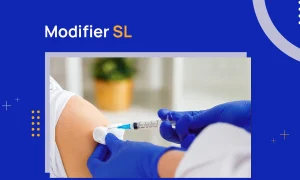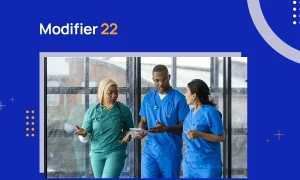Anesthesia sits at the heart of many medical procedures. However, its importance in healthcare is often overshadowed by its complexity. Providers need to get it right, both in how it is administered and billed.
Anesthesia billing ensures that healthcare providers are reimbursed accurately and on time for their services. Medical billers may use modifiers, which are two-digit codes that provide additional information about a service or procedure, to achieve this goal.
One such code used for anesthesia is the modifier 23. Anesthesiologists and CRNAs often use it with anesthesia service codes. But what is it? And how can you use it in your billing? Well, that is what we will find out in this blog.
Our billing experts at NeuraBill have crafted this in-depth blog to provide all the details about modifier 23, including its usage and why it matters. So, let’s get started.
Modifier 23 Description
The modifier 23 is a part of the Healthcare Common Procedure Coding System (HCPCS) Level II modifiers. It is attached exclusively to the anesthesia CPT codes, which range from 00100 to 01999. This range covers intubation, regional blocks, and general anesthesia administration. It describes “Unusual Anesthesia”.
Its purpose? Well, it signals that a procedure, which usually requires no anesthesia or only local anesthesia, was performed under general or monitored anesthesia due to exceptional patient circumstances. The circumstances can vary, like extreme patient agitation, developmental delays, or medical conditions that make local anesthesia insufficient or unsafe.
For example, modifier 23 can be used when a child is too young to stay still or when an adult panics during the procedure. These scenarios demand more than the usual numbing.
An important thing to note here is that 23 is an informational modifier and cannot be used for payment adjustments. This means that it does not affect the reimbursement amount and is only used to justify the situation.
What is Modifier 23 Used for?
To give you a better idea of the situations in which the modifier 23 can be used, let’s look at a couple of real-world scenarios:
Pediatric Emergency Case
Imagine a 3-year-old child had an unfortunate tricycle accident. His parents took him to the emergency room with a deep leg laceration. The wound is covered with dirt and gravel. So, it requires deep cleaning and suturing. Usually, this might be handled with local anesthesia, but the child is hysterical, thrashing, and unable to stay still.
To save time and quickly wrap up the case, the physician orders the administration of general anesthesia. The anesthesiologist then bills the service with a relevant monitored anesthesia care CPT code, for example, 01991 or 01470, and appends modifier 23 to explain the unusual need for general anesthesia.
Unexpected Medical Complexity
Another scenario can be when a patient is undergoing a routine dental extraction. He then suddenly experiences a drop in his oxygen level due to an undiagnosed respiratory condition. What starts as a local anesthesia case escalates to general anesthesia to manage the emergency.
Here, modifier 23 clarifies why the anesthesia team intervened beyond the norm, supporting the claim with detailed medical records.
Accurate Usage Guidelines for Modifier 23
Successfully filing insurance claims with modifier 23 requires adherence to these essential guidelines:
Append to the Accepted CPT Codes
Please note that modifier 23 is exclusively used with anesthesia CPT codes, ranging between 00100 and 01999. It cannot be applied to surgical codes, moderate sedation codes (e.g., 99151-99153 and 99155-99157), or other unrelated services.
Provide Complete Documentation
Another crucial thing to remember is that insurance payers require justification for every code or modifier you use. The same is true for 23. You have to maintain and submit detailed medical records and supporting documents, which include the following:
- A complete description of the procedure performed.
- Justification for why standard or local anesthesia was inadequate.
- Documentation of unusual circumstances (e.g., the patient’s age, severe anxiety, medical instability).
- Records of any relevant consultations with other providers.
Ensure the Correct Modifier Order
The order in which the modifiers are used has a significant impact on the claim. Every payer has different requirements, so before filing the claim, you should check with the insurer.
However, usually, the modifier 23 follows the primary anesthesia modifier that indicates the provider’s role, such as:
- AA: Anesthesia is personally performed by an anesthesiologist.
- AD: Medical supervision by a physician, more than four concurrent anesthesia procedures.
- QK: Medical direction of two, three, or four concurrent anesthesia procedures involving qualified individuals.
A sample claim with this modifier can look like “01991-AA-23” to show that the anesthesiologist performed the service under unusual circumstances.
Modifier 23 vs 59 – Understanding the Difference
A lot of medical billers sometimes get confused between the different modifiers. A frequent confusion seen is between modifier 23 and modifier 59. Let’s clarify their differences:
Modifier 59: Distinct Procedural Service
We have already discussed modifier 23, so we will not repeat it here.
Modifier 59 indicates that a procedure or service was separate from others performed on the same day. For example, anesthesia for a shoulder procedure and a separate knee injection on the same patient.
Key Differences Between the Two Modifiers
| Modifier 23 | Modifier 59 | |
|---|---|---|
| Purpose | Explains unusual anesthesia needs. | Separates bundled services, as identified in NCCI edits. |
| Scope | Anesthesia-specific (CPT codes 00100-01999). | It may be broadly applied across all CPT codes. |
| Scenario | Used when general anesthesia is unexpectedly required for a procedure. | It is used when two distinct services are performed independently on the same day. |
Final Thoughts
Modifier 23 serves as an essential tool in anesthesia billing, highlighting exceptional circumstances that necessitate general anesthesia for procedures typically performed with local anesthesia. When applied correctly, this modifier ensures claims accurately reflect the actual care provided to patients.
The proper use of this modifier can help reduce claim denials. Here is what you must remember:
- It is limited to anesthesia codes 00100-01999.
- Thorough documentation is required.
- It pairs with primary modifiers and cannot be used without them.
If you are having difficulty filing your claims or are facing frequent claim denials, contact our expert billers for the best medical billing and coding services in the USA.



